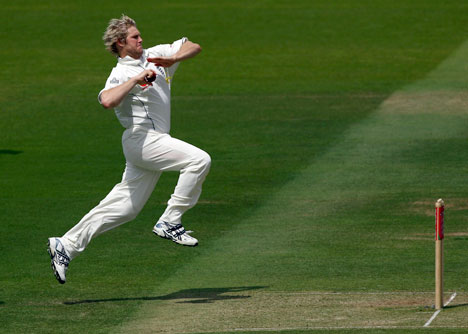I am going with Eddie Paynter played his first test in 1931 and final in 1939 so he is my pick from 1930s

Stats|Matches|Runs|HS| Ave|100s/50s
Ave|100s/50s
First-Class |352|20,075|322|42.26|46/95
Test |20|1,540|243|59.23|4/7
Here is his bio from wiki:
"Eddie Paynter, who died at Keighley on February 5 aged 77, was a left-handed batsman who averaged 84.42 for his seven Tests against Australia, a figure which no other Englishman can approach. This in itself would entitle him to a place among the great, but his figures become even more remarkable if his innings are analysed. In three of these matches he came to the rescue at a grave crisis. On the first occasion, the third Test in 1932-33, he came in at 186 for 5, not a good score by the standards of Tests in Australia in those days, and made 77, adding 96 with Verity for the eighth wicket. In the fourth Test at Brisbane, he was taken to hospital with tonsillitis and doubtless, had all gone well with England, would not have batted. But all did not go well, and at 216 for 6 he emerged from the pavilion, refused Woodfull's offer of a runner, was still there at the close, and returned to bed in hospital. Next morning, he was not out until he had scored 83 in nearly four hours. On this occasion he and Verity put on 92 for the ninth wicket. Normally quick on his feet and a fine driver, he had conserved energy by waiting for opportunities to hit the ball to leg, preferably to the boundary. Few innings in history have so captivated the imagination of the public. Moreover, Paynter insisted on fielding for a couple of hours before retiring and then, as if to show that he was none the worse, in a brief second innings he finished the match with a 6.
In 1938 at Lord's, he came in a 31 for 3 and helped Hammond in a stand of 222, of which his own share was 99. In the previous Test at Nottingham he had broken the record for England against Australia in this country with an innings of 216 not out. In all Tests, Paynter's average was 59.23. In the series in South Africa in 1938-39 he averaged 81.62 scoring a hundred in each innings of the first Test, and 243 in the third. Yet Paynter was 24 when he first made a hundred for Lancashire II, and between 1926 and 1929 he appeared only 11 times for the county without any success. It was not until 1931, when he was 30, that he made his first century against Warwickshire at Old Trafford, gained a regular place, and reached his thousand runs. In 1932 he was inconsistent, but on the strength of some notable innings was selected for the MCC side to Australia. He had been picked for the third Test against New Zealand in 1931 but scored only 3.
It was four years after the 1932-33 tour before Paynter played for England again. Meanwhile, he had made plenty of runs for Lancashire, and in 1936 actually scored 964 runs in August; unfortunately the side for Australia had already been picked. In 1937, however, he could be denied no longer. He scored 2,904 runs with an average of 53.77, including 322 in five hours against Sussex at Hove, and 266 against Essex at Old Trafford, and played in two Tests against New Zealand, missing the third because of injury. Two years later the war virtually ended his career. He resisted pressure to return to the county side at 45, but in 1947, in a couple of festival matches at Harrogate, played innings of 154, 73, and 127, the last taking only eighty-five minutes.
A small man, Paynter was by instinct an attacking batsman, particularly effective against slow spin, but also a fine hooker and cutter who did not spare the fast bowler if he pitched short. He was one of the great outfields of his day and almost equally good at cover - a beautiful thrower with a safe pair of hands. This was the more remarkable as early in life he had lost the top joints of two fingers in an accident. At Lord's in 1938, when Ames had broken a finger, Paynter kept wicket through the Australian second innings of 204, and though he had little or no experience of wicketkeeping conceded only 5 byes and held a catch. A wonderful cricketer."
My playing XI:
@VC the slogger back to you, you have 4 write-ups now

First-Class |352|20,075|322|42.26|46/95
Test |20|1,540|243|59.23|4/7
"Eddie Paynter, who died at Keighley on February 5 aged 77, was a left-handed batsman who averaged 84.42 for his seven Tests against Australia, a figure which no other Englishman can approach. This in itself would entitle him to a place among the great, but his figures become even more remarkable if his innings are analysed. In three of these matches he came to the rescue at a grave crisis. On the first occasion, the third Test in 1932-33, he came in at 186 for 5, not a good score by the standards of Tests in Australia in those days, and made 77, adding 96 with Verity for the eighth wicket. In the fourth Test at Brisbane, he was taken to hospital with tonsillitis and doubtless, had all gone well with England, would not have batted. But all did not go well, and at 216 for 6 he emerged from the pavilion, refused Woodfull's offer of a runner, was still there at the close, and returned to bed in hospital. Next morning, he was not out until he had scored 83 in nearly four hours. On this occasion he and Verity put on 92 for the ninth wicket. Normally quick on his feet and a fine driver, he had conserved energy by waiting for opportunities to hit the ball to leg, preferably to the boundary. Few innings in history have so captivated the imagination of the public. Moreover, Paynter insisted on fielding for a couple of hours before retiring and then, as if to show that he was none the worse, in a brief second innings he finished the match with a 6.
In 1938 at Lord's, he came in a 31 for 3 and helped Hammond in a stand of 222, of which his own share was 99. In the previous Test at Nottingham he had broken the record for England against Australia in this country with an innings of 216 not out. In all Tests, Paynter's average was 59.23. In the series in South Africa in 1938-39 he averaged 81.62 scoring a hundred in each innings of the first Test, and 243 in the third. Yet Paynter was 24 when he first made a hundred for Lancashire II, and between 1926 and 1929 he appeared only 11 times for the county without any success. It was not until 1931, when he was 30, that he made his first century against Warwickshire at Old Trafford, gained a regular place, and reached his thousand runs. In 1932 he was inconsistent, but on the strength of some notable innings was selected for the MCC side to Australia. He had been picked for the third Test against New Zealand in 1931 but scored only 3.
It was four years after the 1932-33 tour before Paynter played for England again. Meanwhile, he had made plenty of runs for Lancashire, and in 1936 actually scored 964 runs in August; unfortunately the side for Australia had already been picked. In 1937, however, he could be denied no longer. He scored 2,904 runs with an average of 53.77, including 322 in five hours against Sussex at Hove, and 266 against Essex at Old Trafford, and played in two Tests against New Zealand, missing the third because of injury. Two years later the war virtually ended his career. He resisted pressure to return to the county side at 45, but in 1947, in a couple of festival matches at Harrogate, played innings of 154, 73, and 127, the last taking only eighty-five minutes.
A small man, Paynter was by instinct an attacking batsman, particularly effective against slow spin, but also a fine hooker and cutter who did not spare the fast bowler if he pitched short. He was one of the great outfields of his day and almost equally good at cover - a beautiful thrower with a safe pair of hands. This was the more remarkable as early in life he had lost the top joints of two fingers in an accident. At Lord's in 1938, when Ames had broken a finger, Paynter kept wicket through the Australian second innings of 204, and though he had little or no experience of wicketkeeping conceded only 5 byes and held a catch. A wonderful cricketer."
My playing XI:
- ?
- ?
Eddie Paynter 1930s
Bob Cowper 1960s
Adam Voges 2010s
Tony Greig 1970s
- ?
- ?
- ?
- ?
- ?
@VC the slogger back to you, you have 4 write-ups now
























